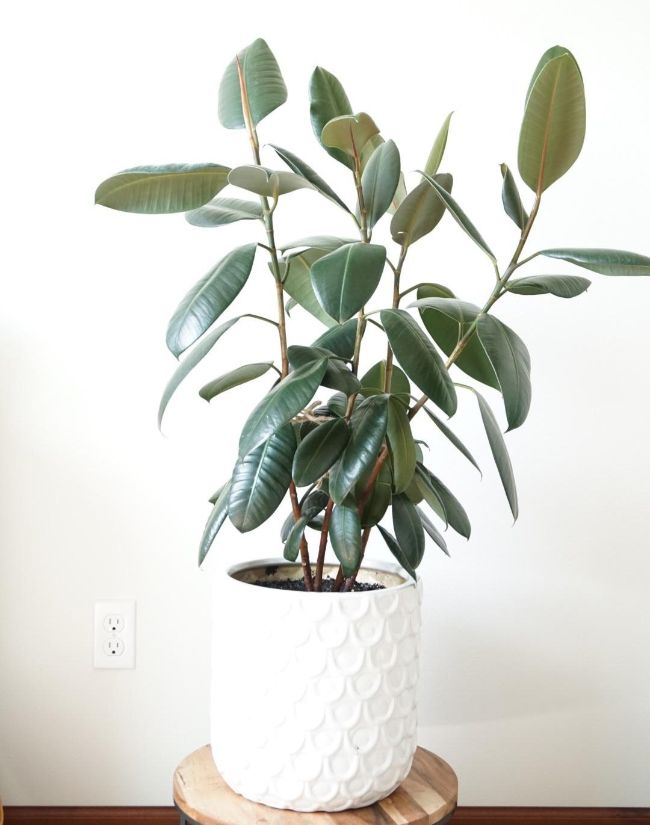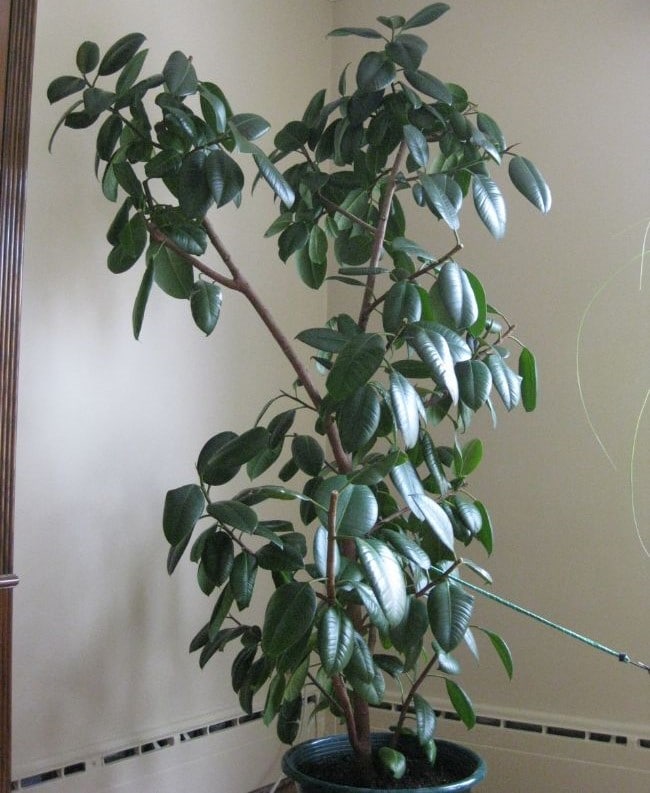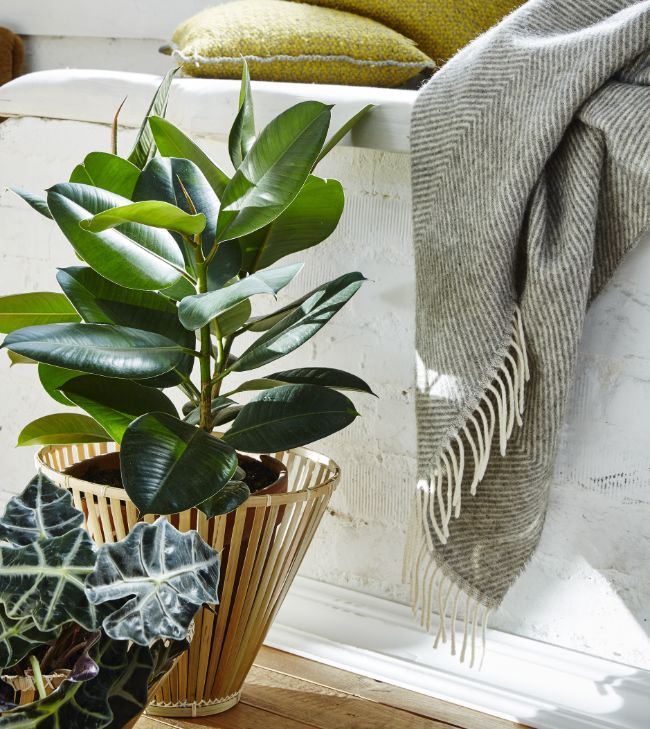The Rubber Plant (Ficus elastica) is popular not only for its beautiful broad leaves and sculptural presence but also for its easy-going nature. The plant responds well to pruning and thrives as a tall tree or a bushy shrub. In this article, we’ll explain how to prune a Rubber Plant to keep it healthy and manageable, and how to give it the shape you want.
How to prune a Rubber Plant: Rubber Plants can quickly outgrow a space, but regular pruning helps them stay healthy and controlled. Through the techniques of topping to halt upward growth and trimming to encourage branching from a lower node, the plant can be shaped into a tree-like form or compact bush.
Overview Of How To Prune A Rubber Plant (Ficus elastica)
The venerated Ficus elastica can reach almost 100 feet high in its natural habitat: a bit problematic for a houseplant. A potted specimen can grow lanky and even break under its own weight. Pruning is the key to a well-mannered Rubber Plant.
It’s easy, too: these agreeable plants are quite malleable to judicious pruning. They can be tamed, strengthened, and shaped over time with some simple techniques. As a bonus, the cuttings readily propagate.
You can prune Rubber Plants throughout the year, but the ideal time is late spring to early summer. New growth may be delayed if you prune out of their growing season.
Individual stems can be trimmed to any length. A minimum of two leaves should be left behind on a small Rubber Plant’s stem, or six to ten leaves on each branch of a larger plant.
Pruning should be done with a sharp, sterile blade. Trim just above a node, or growing point. You can cut straight across or at a 45º angle. New branches emerge below the cut.
Rubber Plants can take a lot of trimming. It’s okay to prune a third or even half the plant at one time, but be aware this affects photosynthesis and so its recovery. If you need to remove more, do it in stages every two or three months to avoid shocking the plant.
Don’t worry if your beloved plant looks a bit forlorn after a major trim. With good care, it will quickly fill in with healthy leaves.

Step One: Make A Plan Before Pruning Your Rubber Plant
Envision the result you want before beginning to prune a rubber plant. Though you can trim the plant into funkier shapes, there are two basic forms: a tall, slender tree with a single spire or a bushier, lower-profile shrub.
After you’ve decided upon the form you’d like, study your plant. Evaluate which branches should stay or be removed.
Once you start pruning, step back occasionally to check the emerging shape.
Pre-Pruning Work
Cleanup extraneous branches:
- Remove dead or damaged stems. Cut them nearly flush with their parent stalk.
- Prune weak branches, including those with a tightly angled crotch.
- Cut off branches that grow down or otherwise interfere with other growth.
- If the plant is overly dense, trim it to allow light and air to penetrate. Pick three branches equidistant from each other and cut them back about a third. If leaf growth is still too heavy, cut these branches back to ½ inch from the central stem.
Mind The Sap
Rubber Plants bleed white latex sap from its cuts. The plant is, after all, from the same plant family that produces natural rubber. The sap can be caustic and messy, so you want to take precautions.
Many people are allergic to Rubber Plant sap. Wear gloves and protect your skin, and be careful to avoid getting it in your eyes.
If you can’t take the plant outside before pruning, cover the floor underneath it. Keep a moistened paper towel handy to clean spilled sap immediately. It dries at room temperature and can stain and harden on a wooden or tile floor—it can be even worse for carpeting.
It’s helpful to wrap the stem with a rag until the sap flow stops, which takes about two minutes. Watch for sap dripping onto nodes, where it could harden and seal off growing points.
Incidentally, wipe off your cutting tools. If sap dries on your shears, it’ll take some effort to open them again!
Important Care Factors
When you prune a Rubber Plant, it will respond much better if it’s healthy. Besides normal care and pruning in the proper season, the key factors below will help make your plant resilient enough to rebound quickly.
Note: If you make changes to upgrade your plant’s care, do it well before major trim work. Acclimate it to new conditions first.
Good Light – Rubber Plants thrive on plenty of bright, indirect light. They can survive on lower illumination, but it’s not optimal. After a heavy pruning, photosynthesis makes a big difference in recovery. Two to four hours of direct morning or late afternoon sun is ideal.
Proper Watering – Rubber Plants tolerate a drought better than a flood. Water them thoroughly when the top inch of soil dries out, but no more. Don’t prune a plant that’s recently been stressed by underwatering or overwatering … and don’t give them extra water in hopes of jump-starting growth.
No Recent Repotting – Pruning is less stressful than repotting, but both operations require energy for recovery. Don’t repot and prune all at once in a big plant makeover.
Normal Fertilization – Extra nutrition won’t make a healthy Rubber Plant grow faster. They aren’t heavy feeders and you don’t want to shock them. Simply maintain their usual fertilization schedule of ½-strength dilution feeding every month during the warm season.

Shapely Pruning: The Tree Form
The slim profile of a tall Rubber Plant tree is a great look for rooms with tall ceilings. To create this form, select the largest healthy stem to be the plant’s central trunk. Trim the other branches to enhance this shape and to concentrate growth. You can cut other vertical stalks down to the soil if necessary.
When removing side branches, cut just above a node to encourage branching. If you don’t wish to stimulate further growth, prune the leaf stem close to the trunk.
Don’t prune the top of your Rubber Plant until it reaches the height you want. When you top the plant, it will stop growing vertically and branch out below that point.
Future trims can focus on maintaining the tall shape. Trim away any vertical branches that emerge to compete with the main trunk.
How To Prune A Rubber Plant To Create A Bushy Shrub
Rubber Plants are great-looking as compact houseplants, too, but this form requires a bit more planning and maintenance.
The first step is to determine the appropriate diameter by considering the existing growth. You’ll need to prune side stems to stimulate branching that will eventually fill in the plant’s middle section: choose a width you can trim down to.
Methodically trim the top and side branches to your chosen diameter. Prune just above a growth node where you want to stimulate branching. Sometimes one new stem will be produced from a cut, sometimes two.
Once new growth emerges, you can trim these stems, too. This will eventually thicken the leaf cover. Wait until the new branch has two sets of leaves before each pruning.
The final form is up to you. To maximize leaf density, continue to regularly prune branches above new nodes. If you want to thin the plant, cut stems back to the trunk.

Major Reconstruction: Repairing Bare Branches
After a branch loses its leaves – either through stress or age – they seldom come back (learn more about the reasons why rubber plants lose leaves here). It’s possible a bare branch can regrow leaves if the plant has high light, humidity, and other ideal conditions, but often the best solution is to prune it back and stimulate entirely new growth.
A Rubber Plant that’s grown too tall but has lost its lower leaves is a common scenario. If you cut off the leafy top, you’ll be left with a bare stem. There are a few ways to address this:
- If you have a healthy plant that’s kept in optimal conditions—like a greenhouse – one strategy is to prune down to the lowest leaves in hopes of stimulating new growth. If it happens, you can cut the trunk down to those leaves, etc., until you arrive at the height you want.
- You can try air layering the bare stem. Once roots have formed you can cut off the top and start a new plant. This takes time, however, and a baggie-wrapped stem isn’t the best look.
- You can replant pruned cuttings in the same pot. If successful, the younger plants can fill in the lower area of the plant.
- You may have luck cutting the stem back to soil level and waiting for new growth, but it’s risky—the plant can only regrow if it has sufficient stored energy to maintain itself without photosynthesis while it produces new leaves.
Propagating Cuttings
As mentioned, you can air layer a bare stem … however, propagating through cuttings is quite easy.
The main rule is to make sure there is a node for leaves to grow from. New growth you’ve pinched off doesn’t have a node, so it won’t propagate.
You can often simply plant a cutting and have it grow into a new plant. If you keep the cutting moist, there’s about a 50-50 chance it will establish and grow into a new specimen.
Here are tips to increase the odds:
- The best cutting size is about six to eight inches long.
- Remove the lower leaves and plant into a damp, well-aerated medium.
- Many growers dip the cut end into rooting hormone first. Adding a heating pad under the planter can also help stimulate root growth.
- Use clear plastic to form a sealed tent over the cutting to preserve soil moisture and raise local humidity.

